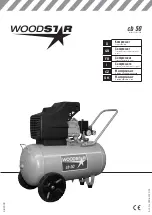
GAS COMPRESSORS / BOOSTERS
GAS & AIR MIXING SYSTEMS
AIR BLOWERS & VACUUM PUMPS
The Utile Engineering Co. Ltd.
Irthlingborough, Northamptonshire, NN9 5UG, ENGLAND
Telephone: + 44 (0) 1933 650216 Facsimile: + 44 (0) 1933 652738 Email: sales@utileengineering.com
www.utileengineering.com
6
IC182
Handling
Skilled personnel working in accordance with safe working practices must carry
out the lifting of machines. Before lifting the correct equipment must be
available. Cranes, jacks, slings, and lifting beams must be capable of carrying
the weight of the machine to be lifted. The lifting eyebolt situated in the top of
the cylinder and a crane hook must be used when lifting or moving the
machine (see fig 3). Do not use the machine ports or the shaft extension for
lifting or moving the machine.
For weights see above in Technical Specification.
Installation
Before commencing installation, a site specific risk assessment, method statement and hazard identification list must be
completed and adhered to. All work must be carried out in a safe area. Utile Engineering trained personnel or those trained
to an equivalent standard should carry out installation, any claims for damage due to faulty installation will be void. The
machine is delivered ready to be connected, with only the removal of the intake and discharge protection covers. All
warning labels and instructions must be observed and retained with the machine. Before installation, ensure there is no
damage to the machine and that it turns freely by hand.
Typical tools required for installation include: -
Set of spanners
Pipe Wrenches
Set of screwdrivers
Hacksaw
Hammer / mallet
Drill (low voltage)
Typical bolt tightening torques are: -
Bolt Tightening Torques
Size
Torque
Size
Torque
M4
4.00 Nm
M12
70.00 Nm
M5
6.00 Nm
M16
100.00 Nm
M6
10.00 Nm
M20
150.00 Nm
M8
18.00 Nm
M24
250.00 Nm
M10
40.00 Nm
Location
The machine should be installed in a clean, dry, well-ventilated area. Allow adequate space and facilities for service,
inspection and future expansion. A minimum of 0.75m of working space around the machine is recommended. Adequate
space around the motor and machine, particularly any fan inlets, is also necessary to facilitate cooling airflow. If several
machines are installed in close proximity, care must be taken to ensure there is no recirculation of exhausted warm air.
Foundation
Simple slab type foundations, designed for static loadings only are satisfactory. The foundations should raise the machine to
a reasonable height above the floor for convenient service and inspection. The use of anti-vibration mounts between the
base and foundation are recommended, these absorb the vibrations generated by the rotating parts of the machine and
insulate it against any vibration in the surrounding environment. Ensure that the anti-vibration mounts are evenly loaded.
Foundation bolts should fix the base.
Electrical Supply and Connection
The voltage rating of the supply must be compatible with the motor and the fittings. All electrical installation must be
carried out by a qualified electrician and in accordance with current regulations and within the framework of the Electricity
of Work Regulation 1990. Ensure all electrical connections, plugs, sockets etc are secure before switching the supply on.
Earthing
It is important that the motor enclosure is soundly earthed by metallic earth continuity conductor, or by separate earth
bonding, but in all cases the installation must be made and tested and approved for this feature by a qualified installer
before the supply is applied to the motor.
Handling
Installation
Fig. 3


































